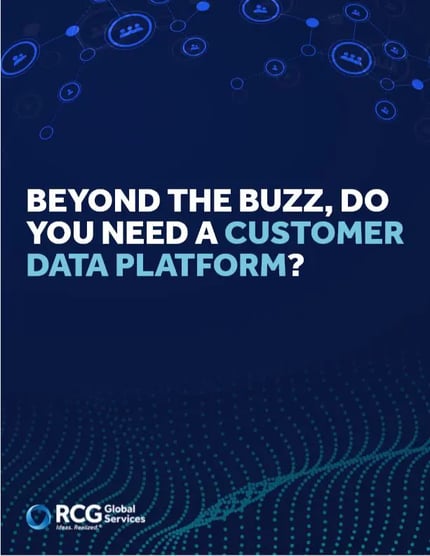Beyond the buzz, do you need a customer data platform?
Make the most of Customer Data, MARTECH, and avoid the shiny new object syndrome.
Customer Data Platforms. Panacea or bust?

Maybe you’ve been asked to evaluate possibilities for CDP or how to build a Customer 360 view or you are actually navigating that process right now or are driving to achieve value from a new CDP implementation. Given the early stage of the CDP industry, many people, while familiar with the term, may not actually understand the term – Customer Data Platform – what it entails, especially in the “jobs a CDP does” versus other platforms. Obvious questions immediately arise, such as “how is a CDP different than a Data Management Platform (DMP) or a Customer Relationship Management (CRM) System?”
Indeed, most understand that customer data analytics are revolutionizing the business world and are essential to digital transformation and customer engagement. A customer data platform (CDP) is a prebuilt technology (packaged solution) used principally by marketers to understand customers and their journey and to drive highly relevant, seamless and frictionlessly-scaled, personalized experiences across marketing, sales, and service channels throughout the entire customer lifecycle/journey.
Despite hype, CDPs have yet to hit their stride in delivering marketers’ dreams for a one-stop, easy-to-use unified customer database for marketing workflows. The reality is there are still many challenges, both in complexity of upstream data and organizational issues that can prevent a CDP from delivering as promised. For instance, firms collaborate with customers in many ways. At the same time “autonomous applications” support each interaction and store information in different formats at siloed locations, with or without data stewardship, governance, and quality measures in place. The job of bringing all the information resident in those systems into a cohesive, unified database is challenging. One reason is that the applications were not built to support this effort.
By combining multiple sources of data (both 1st party data and 3rd party data), marketing teams can now leverage the power of advanced analytics, data science, and machine learning to generate actionable insights and certain levels of marketing automation. Thus, the principal aim of the CDP is to bring together all customer data and stitch that together into unified customer profiles so a marketer can efficiently work with it in a system that is easy to use and also offers marketing capabilities, workflows and tasks.
A short background on the packaged CDP history and industry

Regarding the ongoing quest for the Customer 360 or “Golden Customer Record”, various software products and tools exist to do parts of the job. Yet, marketers still face tremendous challenges trying to have good, clean, integrated customer data with analytics marketing capabilities they could easily use via a unified database. Marketers need the ability to gain all the data required to do a variety of campaigns and analytics. They also want to manage their data with more self-service options rather than wait for the IT department to respond to requests. Various marketing software (marketing automation, personalization tool, campaign management) have databases to support specific marketing analytics such as predictive modeling, attribution, website personalization, or marketing campaign management.
As the marketing needs have evolved, a variety of marketing software platforms have started focusing on unified data. They added features to allow access to the data by other systems – and thus began the CDP. The market was formalized as an Industry in 2016, and things have really taken off. This new CDP industry has experienced quick growth with the size projected to be $1.55B in 2021. There are more than 133 vendors, and the major software (ERP, CRM etc.) players are adding CDP to their existing product portfolios. With the ongoing proliferation of digital transformation, omnichannel marketing, Machine Learning/AI, real-time streaming analytics, and the demand for personalization, the hunger for data and analytics has grown as marketers come to terms with the issues, gaps, and barriers in other options such as Data Management Platforms, CRM, and data lakes, as well as the user-friendly marketing specific functionality touted in CDPs. So, this industry and the variety of CDP platform solutions are aimed at the marketing quest for the perfect system – one with a consistent unified consistent customer view.
According to industry experts, “true CDPs, must be able to ingest any type of data, capture all of the original details, store the data indefinitely, assemble unified customer profiles, and allow any external system to access its data.” As the market evolves, newer CDP solutions are offering enticing marketing features or are embedded in bigger systems to help drive campaign success (e.g., shiny new technology).
Clarifying what a CDP “is NOT” is helpful to understand what it IS

The name Customer Data Platform isn’t just a generic phrase. It represents a specific set of software products just like CRM does. And, like CRM, there are many varieties which we will discuss at a high level in this brief. But the CDP concept is understandably sometimes confused with other marketing and data management technologies. Here is a short starter list of what a CDP is NOT…
a data management platform (DMP)
- DMPs are designed to plan and manage paid digital advertising conducted on 3rd party websites, search platforms, and social platforms for anonymous individuals
a digital event distribution platform
a data lake
- which is designed for IT organizations to store any type of enterprise data (e.g., financial, product, store, service, transaction, HR, customer, marketing) to support enterprise analytics and data science. Data is accessible primarily via programming languages (e.g., SQL, Python, R, Java)
a digital personalization engine
- which is designed to personalize the user experience on an organization’s first-party website
a Master Data Management platform (MDM)
- which is designed for IT organizations within large, multi-channel enterprises to resolve customer identities (PII only) into a single golden identity (which can then be used as input into a CDP).
a multi-channel marketing hub (MMH)
- which is designed to manage and deliver marketing campaigns within email, social, text, and push channels (note: they are sometimes called marketing clouds)
a customer relationship management tool (CRM System)
- which is designed as a sales and service tool for logging direct customer interaction (e.g., customer complaint, price quote on a product, customer questions) and updating basic customer information (e.g., name, phone, email)
Yet, as we will discuss, there are plenty of areas for overlap, duplication, and confusion.
What, then, is a Customer Data Platform?

CDPs collect and structure real-time data into individual, centralized customer profiles. A more formalized functional description is that a CDP is “a packaged software that creates a persistent, unified customer database that is accessible to other systems.”
CDP’s build unified customer profiles by integrating data from a variety of first-, second-, and third-party sources. This includes CRMs and DMPs, transactional systems, web forms, email, and social media activity, website, and e-commerce behavioral data, and much more. CDPs are intended to inform people-based marketing by putting the customer at the center of everything a firm does. This customer-centricity and customer data are increasingly crucial to both business and marketing operations.
One key criteria at the heart of the CDP definition is that it creates a “persistent, unified customer database that is accessible to other systems”. As packaged software, it is usually bought and controlled by business users, most often in marketing. This is different, for example, from a data warehouse or data lake which is usually custom-built by internal or external IT specialists. As an “off the shelf” solution, the packaged nature of the system makes it much easier to deploy and change as new needs arise. One of several attractive aspects of this is that while Enterprise IT typically collaborates in setting up and maintaining the CDP, the most technical resources are usually provided by the software vendor or an agency hired by the marketing group.
A CDP creates a comprehensive and unified view of each customer by capturing and integrating data from multiple systems, linking information related to the same customer, and storing the information to track behavior over time. The CDP contains personal identifiers used in targeting marketing messages and track individual-level marketing results. While data gathered and used by CDPs is primarily gathered by a firm’s internal systems, it is also possible to include other data from external sources and about anonymous individuals. The general focus, however, is on “known customers”. The database is “persistent” in that it retains all details of input data indefinitely or as specified by users and policy.
What does a Customer Data Platform do?

Customers leave behind bits of information – first-party data – as part of each interaction. The CDP ingests this first-party data, and then standardizes and transforms it by matching individual customer identities from each system (that is, customer identity resolution) and combining them into a single consistent and accurate customer profile (aka Customer 360 or Customer Golden Record). Then, the CDP reformats the customer profile data to support a variety of marketing processes and systems which include CRM, marketing analytics, marketing automation, marketing A/B testing, content creation and personalization, and social media outreach and engagement.
This is an ongoing, living process. The CDP continues to 1) ingest new data from various sources and 2) maintain a continually evolving and up-to-date history of customer interactions.
Why is a customer data platform needed?

Collect and unify all first-party customer data
Many of the systems—such as email, analytics, CRM, eCommerce, and social sites—that marketers use operate in silos and don’t pass data back and forth. It’s hard to get a complete picture, and even harder to analyze what you’re looking at. The purpose of a customer data platform is to eliminate those issues by connecting all the tools that marketers use and acting as a single source of truth for first-party customer data.
Provide for customer data management
CDPs manage first-party data and consumer privacy and data rights by controlling the data flows between different marketing systems and managing consent. This is the world of GDPR, CCPA, and data privacy; your business needs to actively manage and document the management of consent and data flows.
Activate customer data
As first-party data is collected, unified, and structured into the individual customer profiles, it can then be used to generate action. For example, audience segments can be created that can be used across the rest of the marketing platforms and channels.
Generally speaking (with a lot of variation by type of CDP), a CDP has the following capabilities:
- Ingest data from any source
- Capture full detail of ingested data
- Store ingested data indefinitely (subject to privacy constraints)
- Create unified profiles of identified individuals
- Share data with any system that needs it (though we note that a CDP is not generally a source system except for specific marketing data)
And a CDP generally is designed to deliver these six (6) functions:
- A single customer view (a key enabler to higher performance)
- Merged databases (CRM, billing etc.)
- Interaction with external touchpoints such as marketing campaign data
- Historical behaviors
- Real-time behaviors on assets/properties (website etc.)
- Offline data from stores, POS, loyalty etc.
- Customer identification including cross-device identification
- Segmentation for multi-channel deployment
- Single segmentation tool for marketing datasets
- Granular segmentation
- Increased targeting of campaigns and customer experience engagement
- Multi-channel marketing and customer engagement automation
- Reporting and Analytics
- Relationships/influence (online vs. in-store)
- Impact of mobile on conversion
- Value of loyalist/advocates (VIPs) in purchasing and Lifetime Value (LTV)
- Customer churn/retention (what are the attributes)
- Predictive modeling & machine learning
- Predict customers’ next moves
- Retain new and disengaged customer to secure Lifetime Value (LTV)
- Increase top-line revenue
- Maximize the potential of marketing automation
- Securing customer data
In addition to the “jobs to be done”, another dimension of CDP performance is that it must also help enable security. Legal and regulatory requirements are on the increase to protect the customers’ right to control/restrict access to their personal data and to have it erased upon request. Meeting these requirements can be challenging when different customer data is siloed across other systems and can easily cause non-compliance. The ability to easily identify specific data points, where they are stored, and what data is being shared throughout the data pipeline is an important benefit to a unified data management platform.
In addition, data stored in the CDP can be used by other systems for analysis and to manage customer interactions. However, the CDP may not be the true source system of record for all data it holds. Some CDPs have differing degrees of capability to restructure the data, add calculated values (e.g., trends and model scores), and share the results in formats that other systems can accept typically through APIs, database queries, file queries etc.
Comparatively, other systems may also provide similar functions to a CDP: data warehouses, data lakes, marketing clouds, eCommerce platforms, and other operational systems, etc. These are sometimes limited in the data sources they can ingest or the access to the Data they assemble. Other systems work only with their own data.
What problem does a CDP solve and what is the value?

They create a constantly updated 360-degree view of the customer from data gathered from every customer omnichannel touchpoint across email, social media, loyalty programs, and in-store transactions as well as existing data sitting in other internal systems, such as CRM, ERP, DMP, and others.
Different departments, with a single pane of view into the customer, can collaborate because they’re able to see who is interacting with a certain customer or not. So, firms can deliver consistent messages and integrated customer engagement across the customer lifecycle.
Further, marketers can more precisely target individual customers and personalize experiences and content delivery to help develop and nurture a lasting relationship that improves loyalty and retention. Data that is collected directly from customers tends to be more complete and more current than data from other sources. This helps marketing efforts be more efficient, effective, integrated, and consistent. Studies show that personalization, for example, can drive five (5) to fifteen (15) percent improvement in revenue and even more improvements in marketing investment and ROI effectiveness – ten (10) to thirty (30) percent.
To recap the top three (3) key areas of pain relief that CDP’s address:
- Efficiency, effectiveness, and efficacy of data
- Utilize the power of data for targeting, prospecting, lack of unified view of the customer, combined data sources, prediction
- Gain data accuracy, quality: collect data directly from customers and prospects
- Use data in insights and action
- Resolve data latency issues
- Help break down data silos
- Unify cross-channel marketing efforts by supplying consolidated, accurate data.
- Trusted, credible data
- Know your customer with Customer 360 / Customer Golden record
- Establish a Trusted Data Foundation
- Manage compliance
- Streamline data platform and centralize customer data infrastructure.
- Customer Recognition
- Match customers across multiple devices and channels
- Understand customer behavior over time
- Tailor messaging by segment, persona, channel
- Attribute results and conversion events due to marketing effort
- Improve targeting
- Address customer identity resolution
- Help manage customer relationships
What are the types of CDPs?

They have been categorized by many vendors, Gartner, and the CDP Institute which is the vendor neutral industry organization for CDP vendors. Understanding the specific goals and use requirements is essential to considering what packaged solution might be appropriate candidates for a tech stack for customer data management and marketing.
Four Types of CDP by functional focus:
Data CDPs
These systems gather customer data from source systems, link data to customer identities, and store the results in a database available to external systems. This is the minimum set of functions required to meet the definition of a CDP. In practice, these systems also can extract audience segments and send them to external systems. Systems in this category often employ specialized technologies for data management and access. Some began as tag management or web analytics systems and retain considerable legacy business in those areas.
Analytics CDPs
These systems provide data assembly plus analytical applications. The applications always include customer segmentation and sometimes extend to machine learning, predictive modeling, revenue attribution, and journey mapping. These systems often automate the distribution of data to other systems.
Marketing Campaign CDPs
These systems provide data assembly, analytics, and customer treatments. What distinguishes them from segmentation is they can specify different treatments for different individuals within a segment. Treatments may be personalized messages, outbound marketing campaigns, real-time interactions, or product or content recommendations. They often include orchestrating customer treatments across channels.
Delivery CDPs
These systems provide data assembly, analytics, customer treatments, and message delivery. Delivery may be through email, website, mobile apps, CRM, advertising, or several of these. Products in this category often started as delivery systems and added CDP functions later.
It is essential to know the key jobs to be done and how those jobs fit within the broader Martech and Data Management/Data Pipeline stack.
How can you use a Customer Data Platform?

- Marketing programs
- Connecting online to offline and marketing attribution
- Customer segmentation
- Customer personalization
- Lead scoring
- Re-Marketing, Re-targeting, and lookalike advertising
- Product recommendations
- Optimizing conversion rates
- A/B testing
- Omnichannel automation
- Improved email deliverability and results
- Better and more online reviews
- Improved customer lifetime value (CLV)
- Data Collection
A main advantage espoused by proponents of CDPs is the ability to collect data from various sources (both online and offline, with a variety of formats and structures) and then convert this disparate data into a standardized form.
Examples of some of the data types a standard CDP should work with include:
- Customer events: browsing activity, actions on a website or in an app, clicks on a banner, etc.
- Transactional Data: data including purchases, returns, data from a POS terminal.
- Customer attributes: Age, gender, birthday, date of first purchase, segmentation data, customer predictions.
- Campaign performance and evaluation data: Impressions, clicks, reach, engagement, etc.
- Customer-company history: data from interactions with customer service, NPS and other customer survey scores, data from chatbots and other bots/digital workers, social media posts, survey data, focus group notes and transcripts and call center recorded audio files etc.
Critical Steps to approaching the decision about a CDP

These might be marketing programs, customer service programs, or sales. Then, the company needs to assess what has been prohibiting marketing from running successful programs, particularly when it comes to customer data, features, and capabilities of the current Martech stack. Consider the following steps:
- Consult stakeholders about adopting a CDP approach: Build vs. Buy (emerging tech)
- Inventory capability and skills for marketing/IT to collaborate for data science, customer modeling, data management and execution
- Determine how and where would/should this fit in a Martech strategy, as well as the enterprise digital and data strategy and roadmap (beyond marketing).
- Define the focus of the CDP effort – type and outcomes
- Document the state of segmentation and personas as well as the status of data, quality etc.
- Assess risk of potential approaches.
- Consider completing a Customer xDNA (CxDNA) roadmap/assessment (depending on the state of persona/segmentation development)
- Execute the roadmap and strategic action plan
Read more about digital, data strategy and roadmaps here at the blog Don’t Implement a Data Lake Sandbox without a Strategy and Roadmap and the RCG e-book, Strategic Context: A Life Hack for Your Business
RCG can help you with your use case develop and design your tailor-fit solution using the latest technology for scalable and sustainable solutions and results that make a difference in your bottom line. To discover how you can maximize your customer data and select the right approach and strategies for data, Martech, and driving business decisions with advanced analytics AI, machine learning, and AI algorithms to create a customer-focused business that results in improved business outcomes that matter, contact me at Rob.Nelson@rcggs.com.
Download a PDF version of this ebook by filling out this form


Designed to be the “Holy Grail” of marketing tech, a CDP is a specific packaged marketing technology focused on unifying and managing known omnichannel customer data. It also provides an insights engine and various marketing management tools rolled into one easy to use system designed specifically for the marketer to tackle the digital age. The truth in expectation is yet to be seen in results. There are many factors and alternative approaches. Any firm should be wary of jumping too quickly due to shiny tech syndrome or risk sub-optimization.
Dr. Rob Nelson, RCG Global Services
